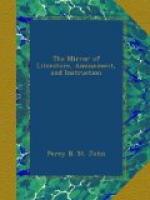We have room but for a brief sketch of Tunbridge Wells. The Springs, or the place itself, is a short distance from the town of Tunbridge. The discovery of the waters was in the reign of James I. Henrietta Maria, Queen of Charles I. staid here six weeks after the birth of the prince, afterwards Charles II.; but, as no house was near, suitable for so great a personage, she and her suite remained under tents pitched in the neighbourhood. The Wells, hitherto called Frant, were changed to Queen’s Mary’s Wells: both have given place to Tunbridge Wells; though the springs rise in the parish of Speldhurst.
Waller, in his Lines to Saccharissa,[1] celebrates the Tunbridge Waters; and Dr. Rowzee[2] wrote a treatise on their virtues. During the civil wars, the Wells were neglected, but on the Restoration they became more fashionable than ever.[3] Hence may be dated assembly rooms, coffee houses, bowling greens, &c.; about which time, to suit the caprice of their owners, many of the houses were wheeled upon sledges: a chapel[4] and a school were likewise erected. The accommodations have been progressively augmented; and the population has greatly increased. The trade of the place consists chiefly in the manufacture of the articles known as Tunbridge-ware. The Wells have always been patronized by the royal family; and are still visited by some of their branches.
Our Engraving represents the Upper, or principal walk, where are one of the assembly rooms, the post-office, Tunbridge-ware, milliners, and other shops, with a row of spreading elms on the opposite side. It is not uninteresting to notice the humble style of the shops, and the wooden portico and tiled roofs, in the Engraving, and to contrast them with the ornamental shop-architecture of our days: yet our forefathers, good old souls, thought such accommodations worthy of their patronage, and there was then as much gaiety at Tunbridge Wells as at Brighton in its best days.
[1] Saccharissa, or the Lady Dorothy Sydney, resided
at Penshurst, near
Tunbridge.
[2] He prescribed eighteen pints of the water for a morning’s dose.
[3] Grammont, in his fascinating “Memoirs,”
thus describes the Wells at
his period, 1664, when Catherine,
Queen of Charles II. was here for
two months, with all the beauties
of the court:
“Tunbridge is the same distance from London that Fontainebleau is from Paris, and is, at the season, the general rendezvous of all the gay and handsome of both sexes. The company, though always numerous, is always select; since those who repair thither for diversion, even exceed the number of those who go thither for health. Every thing here breathes mirth and pleasure; constraint is banished; familiarity is established upon the first acquaintance; and joy and pleasure are the sole sovereigns of the place. The company are accommodated with lodgings in little clean and convenient habitations, that lie straggling




